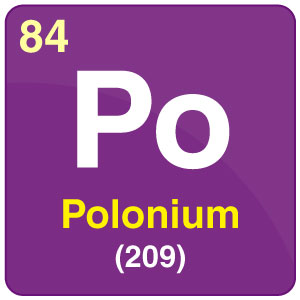Polonium

| Symbol | Po |
| Atomic Number | 84 |
| Atomic Mass | (209) g.mol -1 |
| Discovered by | Pierre and Marie Curie in 1898 |

Table of Contents
- What is Polonium?
- Chemical Properties of Polonium
- Uses of Polonium
- Properties of Polonium
- Certain Facts About Polonium
What is Polonium?
- Polonium is the chemical element with the symbol Po and atomic number 84 in the periodic table.
- This element was discovered by Marie Sklodowska Curie and Pierre Curie in 1898.
Chemical Properties of Polonium
| Group | 16 | Melting point | 254 °C, 489 °F, 527 K |
| Period | 6 | Boiling point | 962 °C, 1764 °F, 1235 K |
| Block | p | Density (g cm−3) | 9.20 |
| Atomic number | 84 | Relative atomic mass | [209] |
| State at 20 °C | Solid | Key isotopes | 209Po, 210Po |
| Electron configuration | [Xe] 4f14 5d10 6s2 6p4 | CAS number | 7440-08-6 |
| ChemSpider ID | 4886482 | ChemSpider is a free chemical structure database. | |
Uses of Polonium
- Polonium is an alpha-emitter, hence it is used in antistatic devices and for research purposes. It is used in the form of a thin film on a stainless steel disc as an alpha-particle source.
- It is used to eliminate static electricity produced during processes such as rolling paper, wire and sheet metal.
- Due to alpha emission, 1 gram of polonium can acquire a temperature of 500 °C. This property of Polonium makes it a useful source of heat for space equipment.
- It is used as a source of neutrons by mixing it or alloying it with beryllium.
- Po210 is used as an atomic heat source. The only disadvantage is the isotope’s short half-life i.e. 138.4 days. Therefore, it doesn’t provide power for long-term uses.
Properties of Polonium
- It is a rare and highly radioactive element.
- Polonium has no stable isotope.
- It’s a silvery-grey, radioactive semimetal found in uranium ores.
- It is chemically similar to elements – bismuth and tellurium.
Certain Facts About Polonium
- The lady, Marie Curie named this element after her native land of Poland. Poland was not an independent country then and was ruled by Russian, German, and Austro-Hungarian partition. With a hope of naming the element after her native land would publicise its lack of independence, Madam Curie did so. It can be said that Polonium was the first element ever to be named to highlight a political controversy.

Comments